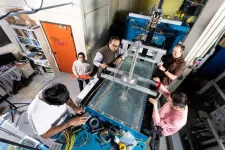(Press-News.org) Public and community engagement in decision making is key to enhancing urban living conditions and the environment in China, a new study says.
There has been significant progress through legislation to promote the role of citizens in environment and nature-based solutions (NBS), but progress in involving the public in projects has been limited, the research shows.
However, there has been some work in gathering public opinion and involving them in the project design and decision-making of government-led and large NBS projects.
Researchers found smaller local NBS projects tend to see higher levels of public participation, whereas larger-scale initiatives often experience minimal engagement. This suggests that project size may influence the extent to which communities are involved in decision-making processes.
The study shows the vital role of NGOs in promoting public participation and highlights the potential for community-based organizations to act as liaisons between local governments and citizens.
The study also identifies private-public partnerships as a promising avenue for financing NBS projects, provided they can demonstrate low financial risk and positive returns for investors. However, it warns that these partnerships may limit public participation to private stakeholders, necessitating targeted efforts to ensure local community needs are addressed.
Dr Carolyn Petersen, from the University of Exeter, said: “There is no doubt that public participation in environmental matters and the importance of taking public opinion into account has evolved and improved over the past 50 years in Chinese law. Public participation became an important part of the law following the Revised Environmental Protection Law of 2015.
Better links between local governments and citizens could be invoked by community-based organisations such as committees of residents. Local community-based organisations, resident committees or similar, could act as a liaison point and catalyst to public participation in NBS projects, although significant training may be required to bring committee members to become effective agents and representatives of local public opinion.”
Researchers say initiatives set by the central government and fed down to the municipal and provincial governments were extremely well planned, designed, and executed and demonstrated consideration towards climate change, carbon sequestration, biodiversity, flora, fauna and migratory birds through reforestation, wetlands, waterways, water recycling, solar panels and park benches.
But there was limited evidence of public input into the educational aspect of these projects, or that the design was what the public wanted.
Researchers carried out a literature review, site visits, and interviews with researchers, local officials and NGO representatives. Between August and September 2022 online and face to face interviews were conducted with local NGOs, academic researchers and government officials in Beijing, Shanghai and Ningbo and site visits took place to projects in Beijing, Ningbo, Guiyang and Shanghai.
Areas examined were the Beijing Olympic Forest Park, Poyang Lake, Lihu Lake, Ningbo Sponge City Project, Guiyang Public Environmental Educational Centre
In Lihu Lake local people were excluded from the planning and decision making, while private real estate companies played an important role in off-setting costs for the intervention because the investment was clearly seen to be profitable for the real estate and tourism sectors.
The successful involvement of the local population in the two Grassroots NBS projects: the Shanghai Community Habitat Garden project and the Guiyang Public Environmental Education Centre, demonstrate that local people are extremely motivated and willing participants in community efforts where they know that they can have an impact upon the environment and their general well-being.
The example of the Guiyang Public Environmental Educational Centre could be extended to Community Resident Committees in other urban areas whereby these committees become a liaison point between the government and local people.
The full article is published in the journal Nature-Based Solutions (ScienceDirect).
END
Public and community engagement key to enhancing urban living conditions and environmental decision making in China, study says
2024-10-28
ELSE PRESS RELEASES FROM THIS DATE:
Bagheri to leverage recycled polyurethane foam for real-world applications
2024-10-28
Bagheri To Leverage Recycled Polyurethane Foam For Real-World Applications Shaghayegh Bagheri, Assistant Professor, Mechanical Engineering, College of Engineering and Computing (CEC), received funding for the project: “Leveraging Recycled Polyurethane Foam for Real-world Applications.”
Bagheri ...
Seeing a black hole's jet in a new light
2024-10-28
Image
Research led by the University of Michigan has pored over more than two decades' worth of data from NASA's Chandra X-Ray Observatory to show there's new knotty science to discover around black holes.
In particular, the study looks at the high-energy jet of particles being blasted across space by the supermassive black hole at the center of the galaxy Centaurus A.
Jets are visible to different types of telescopes, including those that detect radio waves and others that collect X-rays. Since Chandra's 1999 launch, many astronomers have been particularly interested ...
Experienced research leader tapped as CEO of Upstate New York Energy Storage Engine led by Binghamton University
2024-10-28
An engineer with decades of experience in industry and higher education will serve as the CEO of the Upstate New York Energy Storage Engine led by Binghamton University.
Meera Sampath, who holds a doctorate in electrical engineering from the University of Michigan, Ann Arbor, previously was the associate dean of research in Binghamton’s Thomas J. Watson College of Engineering and Applied Science.
Sampath spent the first 20 years of her career with Xerox Corp., including time as the vice president for innovation and business transformation at Xerox Services and as founding director of the Xerox Research Center India. From there, she ...
Lewis Katz School of Medicine at Temple University awarded nearly $1 million in PCORI funding to improve antibiotic prescribing for childhood respiratory infections
2024-10-28
(Philadelphia, PA) – A team at the Lewis Katz School of Medicine at Temple University, part of Temple Health, has been awarded nearly $1 million by the Patient-Centered Outcomes Research Institute (PCORI) to help improve antibiotic prescribing for children with acute respiratory tract infections.
“Many children with symptoms of upper respiratory tract illness who are taken to see a pediatrician end up being prescribed antibiotics, even though they aren’t always needed,” explained Janet Lee, MD, Associate Professor of Pediatrics, Lewis Katz School of Medicine. Dr. Lee and Claire Raab, MD, President ...
A new chemistry for CRISPR
2024-10-28
CRISPR-Cas9 has long been likened to a kind of genetic scissors, thanks to its ability to snip out any desired section of DNA with elegant precision.
But it turns out that CRISPR systems have more than one strategy in their toolkit. A mechanism originally discovered in bacteria, where it has operated as an adaptive immune system for eons, CRISPR is naturally deployed by certain singled-cell organisms to protect themselves against viruses (called phages) and other foreign genetic fragments. Now, researchers at Rockefeller’s Laboratory ...
Giant clam declared critically endangered after the latest assessment
2024-10-28
The giant clam, known for its colorful cape-like mantle, wavy shell and astonishing size, is in danger of going extinct after its population plunged by more than 80% over the last century, according to a new assessment by a University of Colorado Boulder biologist and collaborators.
The assessment, led by Ruiqi Li, a postdoctoral researcher at the CU Museum of Natural History, prompted the International Union for Conservation of Nature (IUCN) today to update the conservation status of this animal from “vulnerable” to ...
DOE awards $12 million to expand marine energy initiatives at Lehigh and partner universities
2024-10-28
The U.S. Department of Energy (DOE) recently granted the Atlantic Marine Energy Center (AMEC) $12 million to expand research and development in marine energy initiatives. AMEC comprises four universities including the University of New Hampshire, Stony Brook University, the Coastal Studies Institute, and Lehigh University.
In total, DOE’s Water Power Technologies Office invested more than $41 million in this latest round of funding using the Bipartisan Infrastructure Law (BIL) to four university-led National Marine Energy Centers located across the country. The centers will use the funds to support research, infrastructure improvements, strategy, administration, outreach, ...
Pythons can swallow even bigger prey than scientists realized
2024-10-28
Burmese pythons can consume prey even larger than scientists realized, according to a new study.
That means more animals are on the menu across southern Florida, where the nonnative, invasive snakes have decimated populations of foxes, bobcats, raccoons and other animals.
Pythons swallow deer, alligators and other prey whole. What they eat is limited in part by how big an animal they can wrap their flexible, stretchy jaws around. Researchers call this the snake’s gape.
University of Cincinnati Professor Bruce Jayne said measurements of snakes captured in and around Everglades National Park show that the biggest pythons have an even bigger gape than mathematical ...
Evidence mounts for dark energy from black holes
2024-10-28
Image
Almost 14 billion years ago, at the very beginning of the Big Bang, a mysterious energy drove an exponential expansion of the infant universe and produced all known matter, according to the prevailing inflationary universe theory.
That ancient energy shared key features of the current universe's dark energy, which is the largest mystery of our time by at least one objective standard: It makes up the majority—roughly 70%—of the universe, but scientists ...
AI might scare us, but can we scare it?
2024-10-28
In recent years, advancements in artificial intelligence have enabled intelligent machines to generate visual art, compose music, and create videos. They converse with us, help with homework, and have even begun competing for our jobs. Amid these advances, machines evoke powerful reactions from humans—sparking concerns about control, fairness, and the potential for misuse. Many feel unsettled by the growing presence of intelligent machines when they inadvertently reinforce power imbalances and perpetuate injustices.
Amid all of this disruption and mistrust, we are comforted to know that machines can`t have emotions. Yet, recent advancements in language-based AI have demonstrated ...



